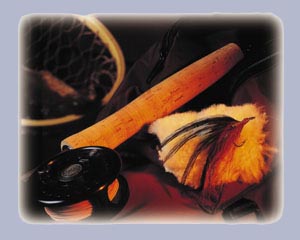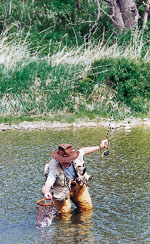From Sir Izaak Walton to Ernest Hemingway, fly-fishing has inflamed and fascinated the
imagination of anglers with its simplicity, its complexities and its romance.Of all the ways to catch a fish, none has so captured
the imagination over the years like fly-casting.
The mystery of the sport -- its classic image of the lone
fly-casting purist, waist-deep in sparkling-clear stream water, enshrouded in the morning
mists of an autumnal mountain pool -- has elevated its romance quotient to a level far
beyond the collective perception defined by writers from Sir Izaak Walton to Ernest
Hemingway. The sport is an integral part of countless works about the great outdoors, from
The Compleat Angler to A River Runs Through It.
But strip away the romance, let reality burn through
the mellow mists of mystery, and fly-fishing is, in the final analysis, one more way to
catch a fish. And a pretty good one, at that.
The Basics
Fly-fishing involves, quite simply, the act of placing a
relatively lightweight bait or lure within close proximity of a fish or into a
fishy-looking stretch of water. Virtually any type of fish, from the tiniest native brook
trout to leviathan-sized blue marlin, can be taken fly-fishing. Most people think of trout
when they think of fly-fishing, however. In Virginia, probably more people use fly-casting
equipment for pan fish and bass than for trout. Still, the fly rod and wading boots are
icons most often associated with trout fishing.
A huge part of the appeal of fly-fishing is the act of casting a
fly rod. Like riding a bicycle, it is a skill somewhat difficult to come by but one which,
once learned, is never forgotten. And, like putting a golf ball, fly-casting technique can
always be improved upon, with practice and enhancements in the equipment used in casting.
There are, of course, countless subtleties involved in one's
casting and presentation techniques, and mastery of the subtleties is where the lines are
drawn separating the casual fly-caster and the serious purist. At any level, however, the
caster must be ever-mindful of the physics of the cast: lifting the fly line off the
water, letting it straighten out on the backcast, then gently urging it forward during the
cast to the target, so that line and leader fall gentle and straight on the water.
The difference between fly-casting and other types of casting is
that with a fly rod, you're actually casting the line rather than the lure or bait. So the
rod and line are of key importance in the sport. There are literally hundreds of different
types of fly rods and dozens of types of line, for different types of fishing, for casting
different types of lures and baits, and for different types of water conditions.
Fly-casting differs from other types of casting also in that the reel is of relatively
minor importance and functions mainly as a place to store line which is not involved in
the cast.
 A fly rod enables the angler to cast a line, at the end of which is a
leader connected to a tippet, on which is tied a nearly weightless lure, or a hook baited
with an insect, a bit of worm, a salmon egg or even a kernel of corn. Lures used in
fly-fishing range from poppers to dry and wet flies to streamers, all of which are
designed to look like some insect, crustacean, minnow or other creature on which the fish
being pursued likes to feed.
A fly rod enables the angler to cast a line, at the end of which is a
leader connected to a tippet, on which is tied a nearly weightless lure, or a hook baited
with an insect, a bit of worm, a salmon egg or even a kernel of corn. Lures used in
fly-fishing range from poppers to dry and wet flies to streamers, all of which are
designed to look like some insect, crustacean, minnow or other creature on which the fish
being pursued likes to feed.
Fly rods can range in cost from about $25 to $1,000 and up, and
are made of materials such as fiberglass, graphite, boron and bamboo. The lines used in
fly-casting range from level lines (even diameter along the full length of the line) to
weight forward (wider line diameter toward the front of the line) to double-taper. Some
fly lines float, some sink slowly and some sink quickly. For almost any kind of fishing,
there is a line designed to get the lure to the fish.
Beyond the rod, reel and line, there are a plethora of
accouterments available to the fly-fishing angler. Various types of wading boots, fishing
vests, hats and caps, nets, tackle holders, wading staffs, polarized sun glasses and other
accessories can all be added to the angler's collection of fishing gear as time
progresses. In fly-fishing, as in many hobbies, collecting the accessories becomes
something of a hobby in itself. It's just one facet of fly-fishing's appeal.
The Fish
Somewhere in the misty-morning myths of angling lore, someone saw
a fish rise to take a struggling insect or frog on the water's surface and thought,
"How can I imitate that?" And thus was born the idea which has evolved into
modern fly-fishing.
The fish in question may have been a trout, it may have been a
bluegill, it may have been a largemouth bass. All are, today, popular quarries for the
fly-fishing enthusiast.
In Virginia, most fly-fishing is done in fresh water, although
there are ample opportunities for salt-water fly-fishing and the sport is becoming
increasingly popular in the Old Dominion.
But for no other reason than simple accessibility, most Virginia
anglers fly-fish in fresh water. For the same reason, simple accessibility, most
fly-fishing anglers in Virginia pursue warm-water species such as largemouth and
smallmouth bass and pan fish.
Almost any farm pond, lake or river in Virginia provides
countless opportunities for catching bass and bluegills on a fly rod and popping bugs, and
many Virginia rivers, such as the James, the New and the Shenandoah, are ideal spots to
fly-fish for smallmouth bass.
Trout fishing in Virginia has evolved into an industry far above
and beyond the sale of fishing tackle. The state's Department of Game and Inland Fisheries
has an extensive trout-stocking program supported by hatcheries at Marion, Paint Bank and
Wytheville and rearing facilities at Marion, Williamsville and Montebello. Virginia's
trout fishery consists of brook, rainbow and brown trout, and is mostly confined to the
western half of the state, where the high elevations and limey soil create water
conditions most conducive to trout vitality.
The state's stocking program consists of three main parts:
catchable-trout stocking, a wild trout program and fingerling-trout stocking. The
catchable-trout program is best known and involves regular stocking of legal-sized fish in
streams open to the public, from October 1 through late May or early June, depending on
stream conditions. The wild trout program includes management of naturally reproducing
populations of brook, rainbow and brown trout. The fingerling-trout stocking program
involves planting fish smaller than the legal length limit which will adapt to their wild
surroundings and grow wild as they grow larger.
There is also an urban trout-fishing program in which selected
lakes and ponds are stocked with catchable trout from November through April. This program
currently includes six lakes: Cook Lake (Cameron Run Regional Park) in Alexandria, Locust
Shade Pond in Prince William County, Dorey Park Lake in Henrico County, Shields Lake (Byrd
Park) in Richmond, Lake Biggins (Huntington Park) in Newport News, and Northwest River
Park in Chesapeake.
There are also numerous state-run and private fee-fishing areas
throughout the western half of the state. One such area, privately run, is Escatawba
Farms, near Covington, owned and operated by Derrick Barr.
The Romance of the Sport
In many ways, Barr embodies all of the characteristics associated
with the romance of modern fly-fishing. His family purchased the farm in the 1940s and his
grandfather, Ellis Barr, raised registered Hampshire hogs on the land in addition to
operating a chain of variety stores and serving as president and chairman of the board of
Covington National Bank.
"My grandfather always enjoyed this place," Barr notes.
"He came here every day at two in the afternoon, and as a child, growing up in
Lewisburg [West Virginia], I came here every weekend."
Barr moved to the farm in 1980 and began fishing the trout stream
which runs through the property. "That's when I was bitten by the bug," he says
with a laugh. His decision to turn the two miles of high-gradient, spring-fed trout stream
into a fee fishery came after a discussion with a neighbor, Rose Humphries, who serves
with Barr on the local Extension Leadership Council.
Humphries, who operates the Old Earlehurst Bed and Breakfast Inn
near Escatawba Farms, said a high-end trout fishing operation would attract desirable
tourism to the area and might help Barr to keep operating his land as a farm. Barr liked
the idea, began obtaining the necessary permits for such an operation, and in February
1999 the trout fishery went into business.
Barr's operation is a catch-and-release fishery offering brook,
brown and rainbow trout in pristine natural settings. "We try to make sure the fish
get back into the water as soon as possible to avoid injury," he notes. "And our
clients are encouraged to follow the Golden Rule of angling - respect your fellow anglers,
and practice good sportsmanship."
Fly-fishing only is allowed at the farm, and a fly-fishing school
as well as fly-tying classes are offered through the business. Guides are available to
assist anglers fishing Escatawba Farms' waters.
"We work with the state Department of Game and Inland
Fisheries, which offers technical services to landowners, and we also work with the state
Extension Service," he notes.
"In 1999, we had a group of Virginia Tech students who used
this fishery as a case study," he continues. "All of this is helping us to keep
the farm operating as a farm. We're working to avoid having to subdivide the land into
three-acre farmettes. This is all about stewardship - we're just trying to take care of
the land for the next generation."
This conservationist tendency is characteristic of serious
fly-fishing anglers. "There's a sort of natural progression to fly-fishing,"
says Billy Kingsley, co-owner of the Blue Ridge Angler, a full-service fly-fishing shop in
Harrisonburg. "A person moves from spin-fishing to fly-fishing, then starts tying his
own flies, then gets into stream ecology, then ultimately becomes an amateur
entomologist."
Along the way, the angler naturally develops a deep love and
respect for the processes -- grand and minute -- involved in the life of the trout, from
the way acid rain can affect a stream to the frequency of mayfly hatches on a given
section of water.
"I grew up on a spring-fed stream," Kingsley says.
"But Virginia has a good variety of ecosystems - mountain streams with native brook
trout, spring streams with brook and brown trout, cold lakes, and limestone streams in the
Valley.
"Virginia is a good trout state, but it's an even better
smallmouth bass state," Kingsley continues. "For smallmouth bass, Virginia is
one of the best states in the country. The south fork of the Shenandoah River is an
amazing bass fishery," he notes. "The last few years, with all the drought
conditions affecting trout streams, a lot of fly-fishermen have gotten discouraged and
re-discovered how much fun it is to chase smallmouth bass with a fly rod," Kingsley
adds with a laugh.
Fly-fishing is a realm which, once entered, seems to expand
eternally. It is science, it is art, it is fun. It is, for many, the stuff that dreams are
made of.